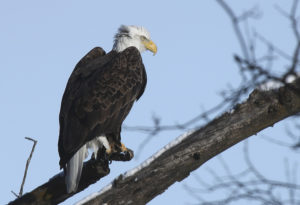What’s for Dinner?

Bald eagle photo by Carl Kurtz
He’s out there again, I mutter to myself, and rush to grab the spotting scope. I find him in the scope, and discover he’s looking at me! Majestic, yet his intense laser-like stare suggest a ferocity beyond anything I would want to mess with. He’s on one of his favorite perches, a log jutting out of the ice roughly six feet above the pond’s surface. Why is this animal, our National bird, whose image is on our Great Seal and many of our gold and silver coins, here? I’m determined to find the answer.
This fall, we’ve frequently seen a mature bald eagle, and occasionally an immature bald eagle, hanging out in our valley. We aren’t near any large bodies of water, and our land is primarily uplands with only a small fishless pond of open water. Bald eagles primary diet is fish, but I’ve seen them chase waterfowl near the pond, so their presence did not surprise me. But now, weeks after the pond has frozen, the eagles are still around. I reason they can only be here for one purpose – food. But what are they eating?
The first stop in my investigation is the pond. The eagles have two favorite perching spots, so I check them both out. I find a few scattered eagle feathers laying on the ice. I leave them be, as eagle feathers, and other parts, are protected under the Bald and Golden Eagle Protection Act. I notice if I get the angle right, I can see the clouds’ reflection on the icy surface. Does the eagle come here to admire itself? Not likely. I suspect wild animals don’t have the luxury of being vain. The ice and water are crystal clear. Movement under the ice catches my attention. Water bugs and tadpoles sluggishly swim by. Green frog tadpoles are big. Would an eagle go after these? Maybe, but certainly not through two inches of ice.
At the next perch spot, I find something more promising. Air bubbles are trapped under the ice, and several muddy channels in the pond bottom are visible. Muskrats. They likely have an air hole around here somewhere in the pond bank. I bet an eagle would not pass up a chance at muskrat for dinner.
My next stop is another favorite perch, located at a large oak near the base of a steep rock outcropping that projects out into the prairie below. I search around at the base of the oak tree and find bits of opossum fur, some with hide still attached, and a squirrel hide. Did the eagle eat the opossum and squirrel? Quite likely, but I wonder what else it’s looking for when up in the top of the oak?
Minutes later, breathing heavily, I’m on top of the rock outcropping. The view is commanding, and soon my eyes are following the maze of game trails cutting through the prairie grasses below. It doesn’t take me long, and I find four locations marked with circular, matted grass. I take a visual bearing on each location and head back down to the valley bottom to investigate.
I find four deer carcasses, or rather, just heads, a lot of hair, and a few larger bones – three bucks and a doe. Two of the bucks are old, judging by the size of their antlers. After inspection of the doe’s teeth, I determine she’s old, too. Normally, a deer carcass doesn’t last long, but with four of them in close proximity, no doubt the eagles were able to share in the bounty.
What killed these deer? Due to the deer age, I consider chronic wasting disease – an infectious prion disease similar to mad cow. Many older deer in our area now carry the disease. I wonder what will happen to species such as eagles and turkey vultures if our deer population drops drastically from chronic wasting disease. Our abundant deer population, and their carcasses, feed a lot of critters.
But, given the time of year, hunting season, and based on previous experience, it’s likely the deer were wounded and lost by hunters. Another concern immediately enters my mind – lead poisoning. Eagles are very vulnerable to lead poisoning. Unlike waterfowl hunters, deer hunters don’t use steel bullets.
Concerns aside, I consider just how lucky I am to have the opportunity to share part of my life with the bald eagle. No other animal better represents the hope and faith I have in my own kind that we as a society can come together and accomplish a conservation success.
Decimated in population to around 400 breeding pairs in 1963, the bald eagle was one of the first species to receive protection under the precursor to the Endangered Species Act in 1967. Along with the banning of insecticide DDT in 1972 by the newly created Environmental Protection Agency (EPA), and decades of conservation efforts by both private and government groups, the bald eagle has soared back in numbers and once again graces our skies in the lower 48 states.
Bald eagles are much more than our national bird or the symbol of our Great Seal. They are our emblem of conservation success, a reminder that people in this diverse nation can come together and save a species.
I hope we will find our path forward together and save many more.
Originally published in Environmental Returns.


